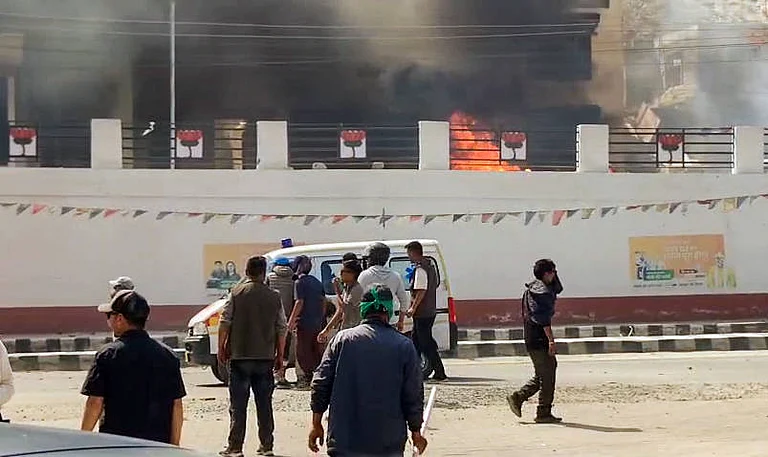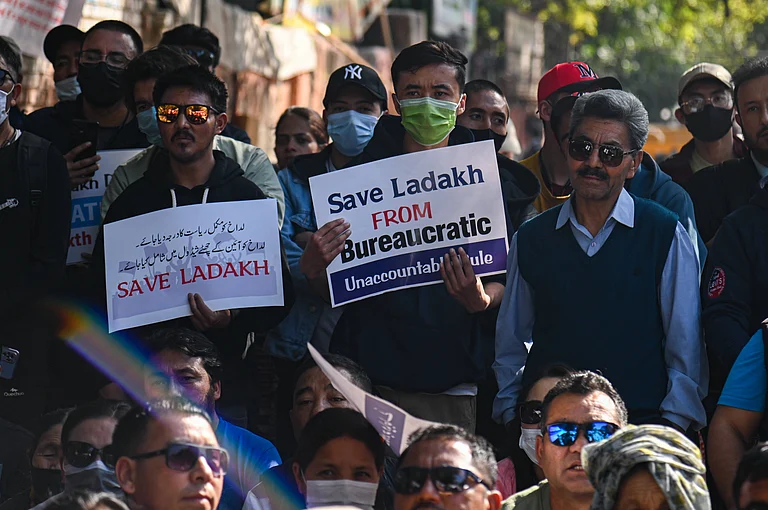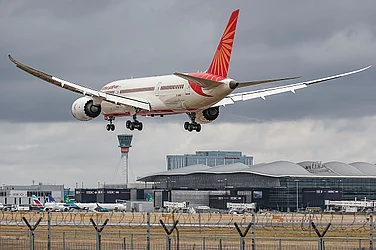Global warming has been leading to melting glaciers in the Himalayan region, where Ladakh is located. Shifting weather patterns are resulting in frequent flash floods, landslides and droughts that are impacting the lives of people living in the sparsely populated villages in the region.
In 2019, when Ladakh was carved out into a Union Territory after Articles 370 and 35A were abrogated, people in the region were happy, but locals feel that ‘freedom’ from Jammu & Kashmir has come at the cost of the special status which the now abrogated Article 370 had granted. They are fighting to protect the region’s identity, land, environment, and autonomy.
In September 2019, the National Commission for Scheduled Tribes recommended the inclusion of Ladakh under the Sixth Schedule, noting that the new UT was predominantly tribal—more than 97 per cent—and its distinct cultural heritage needed preservation.
The Sixth Schedule contains provisions that grant indigenous tribes significant autonomy. It provides for the formation of Autonomous District Councils (ADCs) that have legislative and judicial powers. These councils can make rules and regulations governing land, forest, water, agriculture, health, sanitation, inheritance, marriage and divorce, mining, and more.
Ladakh is home to nearly 300,000 people living in its two districts—the main city of Leh, which is predominantly Buddhist, and Muslim-majority Kargil. Both regions are now seeking more constitutional safeguards, including statehood, with an elected legislature empowered to make laws for its people.
However, after the initial proactive steps taken by the Union government, it has been silent on the issue. The failure on the part of the government to act on the demand for the extension of the Sixth Schedule of the Constitution to Ladakh prompted climate activist and innovator Sonam Wangchuk to go on hunger strikes. Wangchuk, who is currently on the fifth day of his 'Climate Fast' says he will fast unto death if Ladakh's demands are not fulfilled.
"Ladakh was promised Sixth Schedule safeguards twice in election manifestos but now the Govt backtracked after winning 2 elections. Through this struggle we want to set a good precedence for all times to come," his Instagram post read.
Sonam Wangchuk and leaders of other civil society groups had in February announced an indefinite hunger strike, which they called off when the Centre agreed to discuss their demands. However, talks between the union territory representatives and the Union government failed, leading to the current strike.
Sonam Wangchuk has previously participated in several hunger strikes—in January last year he went on a five-day hunger strike in sub-zero temperature, and in June he went on a 10-day hunger strike. He has said he will continue with his hunger strikes until his demand for the Sixth Schedule to protect the fragile environment of Ladakh, its mountains, glaciers, land, people and culture is fulfilled.
In an interview with Chinki Sinha in September 2023, Wangchuk highlighted the importance of the Sixth Schedule, the impact of climate change on Ladakh, why the region, especially Leh city, could not take more tourists and why more infrastructural development should not be allowed in Ladakh.
Why do you think the Sixth Schedule is important for Ladakh?
I want to use all the provisions that are available to safeguard the Himalayas, and I personally feel the Sixth Schedule is a good tool. It already exists. It has not been opposed by anyone. All parties have vouched for it; the BJP has promised it. So, why wait? It is good for Ladakh. People have been talking about it for the past 25 years. Leaders have been discussing that if Ladakh gets UT (Union Territory) status, how would we save it, say, from industrialisation. Now that we are a UT, the discussion has started again.
Why has the government not acted on it yet?
Our MP (Jamyang Tsering Namgyal) took up the issue (in August 2019). The government was very generous, supportive and proactive then. Even Arjun Munda, the tribal minister, came here in 2019. He said that we must safeguard Ladakh under the Sixth Schedule. Simultaneously, the NCST (National Commission for Scheduled Tribes) and others held meetings in Delhi. They said Ladakh is the most suitable candidate for the Sixth Schedule. But when nothing happened, I made this video, ‘Ladakh ke mann ki baat’, addressing the Prime Minister. The tribal minister wrote to me personally and assured me that the Sixth Schedule will happen. But there was silence after that.
Why wasn’t the status granted to Ladakh earlier? Also, can a person like me buy land here now?
It didn’t happen earlier because at that time Ladakh was under Article 370. And they were not interested in giving Ladakh anything special. But if we still don’t have the Sixth Schedule, then we are out of the frying pan and into the fire. Regarding buying land, it's a grey zone because Article 370 is gone and new things have not happened. There are no policies. But technically it may even be possible. And if it continues like this, then rich people will buy whole valleys and mountains. This is why safeguards are needed.
There's a lot of identity politics as well.
The Sixth Schedule is a beautiful instrument which allows the government to give rights to local people to manage their region. But we need hill councils that have lawmaking rights. Right now, people who know nothing about Ladakh are sent here and given three years. In the case of fragile ecologies, locals should be given the autonomy to manage their region. In Ladakh's case, we are lucky to be 97 per cent tribal, so the Sixth Schedule is the best mechanism.
How do we make people in other parts of the country care about Ladakh?
My way is to sit on an anshan. If I sit hungry for 10-20-30 days, people will wonder why this man is dying. I am a problem solver. As a problem solver, you must have empathy and you must want to bring in change. That made me an educationist. When I saw that we were harming nature and it was punishing us with flash floods and droughts, I shifted my focus to this. I have seen in front of my eyes the towering Khardung La glaciers reduced to nothing. I question the system, but I also come up with alternative models.
How is climate change impacting Ladakh?
Ladakh is fragile. Even the Prime Minister has talked about making Ladakh carbon-neutral. You shouldn’t be taking diesel taxis on high passes …

… But the Army also uses a lot of diesel.
Army is a necessity. Tourism is leisure. So let's not mix the two. Army can't be forced to use solar batteries. For tourists, you can have bindings. Individual taxis should not be allowed on the passes; only shared public transport or electric cars should be allowed.
You have studied Ladakh’s ecology. How dangerous is the situation now?
At the local level, people's lifestyles need to change, government's policies need to change. The second part is the global angle—global warming. We hardly contribute, but we get the flack. People in big cities need to change. We are dying because of your behaviour. So we can be a voice, an SOS voice. It’s a fact that the temperature is rising because of which our glaciers are melting …
And the Himalayas are vulnerable compared to the rest of the world …
Global warming is also a result of local activities. Glaciers are melting because of the rise in temperature and also because black carbon from the tail pipes of trucks and buses is going up in the air and making the glaciers black. Black absorbs the sun’s energy and leads to glaciers melting. Last year, Kashmir University published a research paper after studying 17 glaciers in the Drass area. They found that glaciers which are close to the highway are melting faster. Ladakh is at an altitude where only 60-70 per cent of fuel is burnt. Because of the altitude, there is not enough oxygen, and therefore a car that gives you 10 kms for a litre will only give you six-seven in Ladakh.
Locals are saying that Ladakh has changed. The rainfall is erratic, glaciers are melting, there is no water …
You have to act sensibly if you are living in the sensitive Himalayan region. Burning of wood for cooking should not be allowed. Efficient stoves should be provided for cooking or heating, or the use of solar energy should be promoted.
But the government has to take care of this …
If people demand it, the government will act; if not from a climate point of view, then at least for votes. Here in Ladakh, heating can be easily done with the help of the sun. In this room, no heating has taken place in five years. At our school, for the past 36 years, no fuel has been used.
But how do you spread this message across?
Solar energy must be promoted. The government will have to give subsidies. Solar houses need high insulation because they have to trap the heat. Insulation cost is not taken into account at the construction stage. Besides, solar houses need double or triple glazing. No one wants to spend on all this because they are not doing all this for themselves but for the old glaciers. But why should the poor Ladakhi farmer bear all the cost?
Why are all these things not getting into policy?
The government has given subsidies on cars, but how many people use cars? Electric cars have 30 per cent subsidy, but how many people use these? One hundred per cent of the population cooks, so subsidies should be given for cooking.
Promoting tourism in ecologically fragile Ladakh is a double-edged sword. What is the way out?
We must look at sustainability more than immediate income. We should promote tourism for income, but not beyond a point where its negative impacts outweigh the benefits. We must take into consideration the carrying capacity of towns and the passes. Management is an issue. If you let five lakh tourists descend on five square kilometres (Leh city) in the five months of summer, then it is a toxic concentration. We must bring the numbers down.
And how do we do that?
Either you bring the numbers down or you spread out the tourists to Kargil, Zanskar, Drass, Nubra, and other places. Promote rural tourism. No new hotels should be allowed in Leh city. What we are seeing now is that 70 per cent of new construction is happening in Leh. Even if you don't put an embargo, don't at least support this. Don't give any loans or subsidies for new construction. Support de-centralisation, spread out the infrastructure.
But wouldn’t it be dangerous if infrastructure is allowed to spread out like this?
No, because then these other places will also get to reap economic benefits. Young people won’t be forced to come to Leh for work. Right now, around two lakh people from the neighbouring areas are coming to Leh in summer to cater to the five lakh tourists because the other places are not developed in terms of tourism. It’s dangerous. Further development of tourism or other infrastructure must stop and we must make our villages liveable.
If construction happens in small villages—like Nimmu, for instance—isn’t that bad?
Nimmu having some construction is not a bad thing because it would mean people from Nimmu are not building hotels in Leh. Earlier, even people from this village, which is just 20 minutes from Leh, were building hotels in Leh. If people want to create economic opportunities in Nimmu by building hotels, that’s not a bad thing because they will get to stay in their village.
But how prudent is it to have hotels in these small villages?
Tourism in rural areas can be different from Leh. People in Nimmu can, maybe, build homestays to augment their income. They can transform their farms and gardens into hotels and guest houses and bring tourism to villages, so that, along with agriculture, they can have guests paying cash. Agriculture here is not that lucrative. This money is not enough for the new generation which has aspirations. Barley, wheat and a few apricots may not attract tourists, but a well-thought-out homestay will bring colour to the village. It will be like a beautiful Shangri-la where scholars from Bengaluru or America can come and stay and give intellectual company to the girl in the house doing her MA or B.Tech. These guests will leave them with enough income. Then they can continue farming and hospitality together. In Leh, people are completely into tourism and have left the village farms to dogs.
That’s a bad model because you find only old people in these villages.
What we're trying here is to make young people stay in villages and help their parents so that together they can make it a viable unit. Nimmu is on the highway. But we want to implement this even in villages in the interiors, like Pang, which is way up. Some families there have homestays, but they don’t get frequent tourists.
But how would you pitch a village like Pang to tourists?
Farm stays are not guest houses, hotels, or even homestays. A farm stay is a destination. You come, and you help the family. You go to the fields, harvest, milk the cows, and pull out vegetables. You can visit the highland valley where there are wild animals, lions, including snow leopards, and all kinds of wild goats and sheep and glaciers. You will get to become a part of an authentic experience. How many people are willing to do this depends on what image Ladakh manages to build. One movie was released and everyone flocked to Pangong Lake. Ladakh UT should not spend any more money on promoting that tourism because it has been done to death. Now spend money on experiential tourism—where you show your children what it takes to grow and bring food to the table.
If you had to define Ladakh in one sentence, how would you describe it?
Ladakh is a gift of nature to the planet and humanity. We have so many resources; both locals and tourists should help in preservation. It is also the responsibility of the 1.9 billion people—a fourth of the global population—living in north of India, south of China, and those living in the Himalayan and the Hindu Kush regions, who get fed by the glaciers.

























